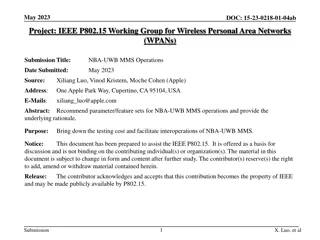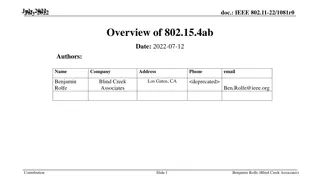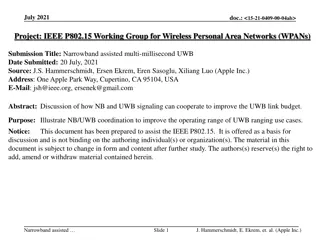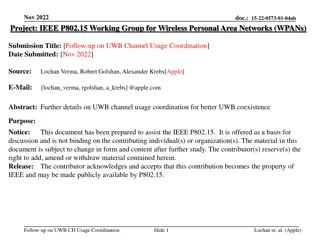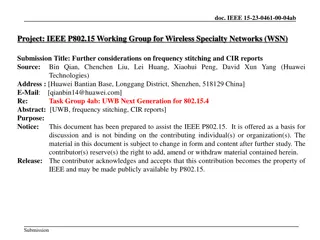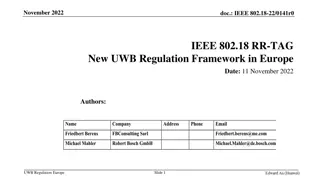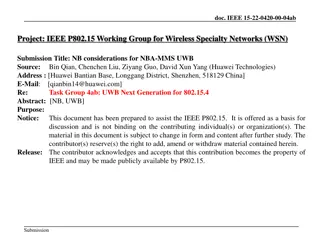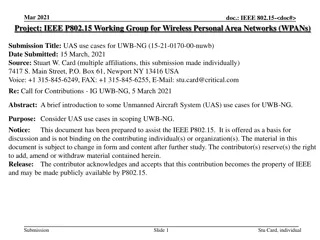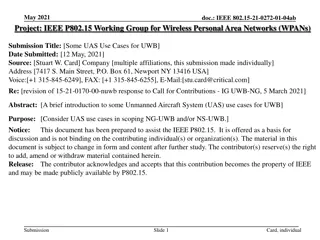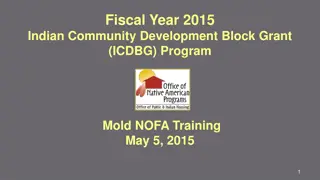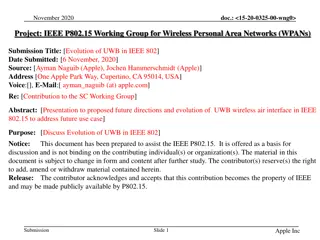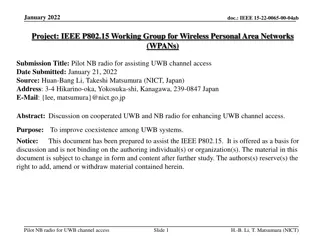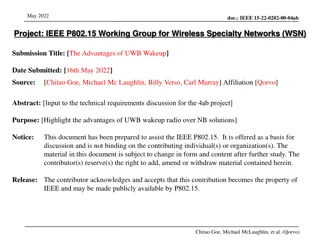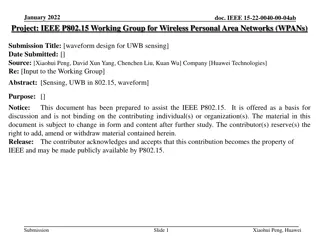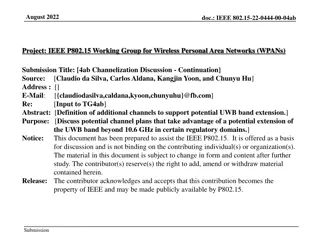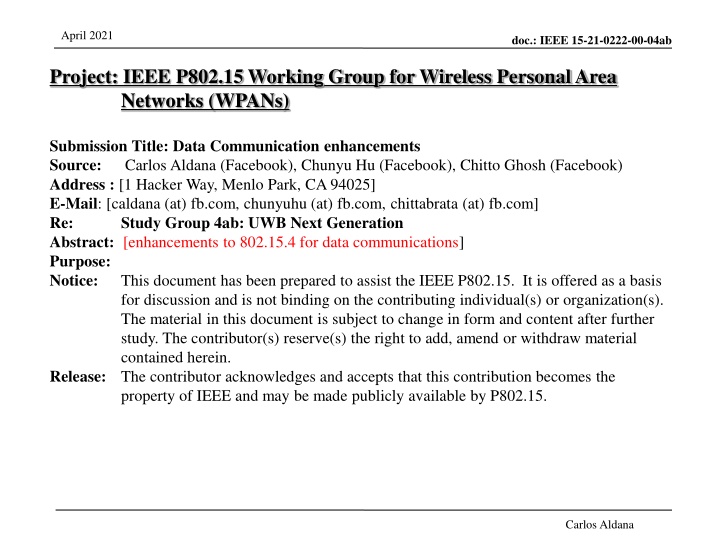
Enhancements in Data Communication for IEEE P802.15.4 WPANs
This document outlines enhancements for data communications in the IEEE P802.15.4 Working Group for Wireless Personal Area Networks (WPANs). The focus is on improving low latency, channel capacity, battery life, integrity, and efficiency in data transmissions using Ultra-Wideband (UWB) technology. Key features include new orthogonal preamble, advanced coding options, increased bit rates, and efficient medium sharing. These improvements aim to achieve higher throughput, smoother rate vs. range curves, and enhanced MAC and PHY efficiency.
Download Presentation

Please find below an Image/Link to download the presentation.
The content on the website is provided AS IS for your information and personal use only. It may not be sold, licensed, or shared on other websites without obtaining consent from the author. If you encounter any issues during the download, it is possible that the publisher has removed the file from their server.
You are allowed to download the files provided on this website for personal or commercial use, subject to the condition that they are used lawfully. All files are the property of their respective owners.
The content on the website is provided AS IS for your information and personal use only. It may not be sold, licensed, or shared on other websites without obtaining consent from the author.
E N D
Presentation Transcript
April 2021 doc.: IEEE 15-21-0222-00-04ab Project: IEEE P802.15 Working Group for Wireless Personal Area Networks (WPANs) Submission Title: Data Communication enhancements Source: Carlos Aldana (Facebook), Chunyu Hu (Facebook), Chitto Ghosh (Facebook) Address : [1 Hacker Way, Menlo Park, CA 94025] E-Mail: [caldana (at) fb.com, chunyuhu (at) fb.com, chittabrata (at) fb.com] Re: Study Group 4ab: UWB Next Generation Abstract: [enhancements to 802.15.4 for data communications] Purpose: Notice: This document has been prepared to assist the IEEE P802.15. It is offered as a basis for discussion and is not binding on the contributing individual(s) or organization(s). The material in this document is subject to change in form and content after further study. The contributor(s) reserve(s) the right to add, amend or withdraw material contained herein. Release: The contributor acknowledges and accepts that this contribution becomes the property of IEEE and may be made publicly available by P802.15. Carlos Aldana
April 2021 doc.: IEEE 15-21-0222-00-04ab Data Communications Slide 2 Carlos Aldana
April 2021 doc.: IEEE 15-21-0222-00-04ab Data Communications Motivation Growing market interest in having low latency data communications using UWB while reducing on-air transmissions Greater channel capacity Increased battery lifetime Less interference among the devices Increased integrity due to smaller time window for any attacks Slide 3 Carlos Aldana
April 2021 doc.: IEEE 15-21-0222-00-04ab Data Communications Overview A mandatory length 91 ternary code was added in 4z HPRF mode was introduced PRF of 249.6 MHz providing 27.2 (RS)/31.2(no RS) Mbps PRF of 124.8 MHz providing 6.8 (RS) /7.8 (no RS) Mbps For PRF of 249.6 MHz, the following structure is used (8 pulses per bit), with symbol duration = 32.05 ns PRF: Pulse Repetition Frequency RS: Reed Solomon Convolutional codes are used with K=3 and K=7 Slide 4 Carlos Aldana
April 2021 doc.: IEEE 15-21-0222-00-04ab Non-data communications block based mode (6.9.7.3.3 in 15.4z-2020) Slide 5 Carlos Aldana
April 2021 doc.: IEEE 15-21-0222-00-04ab Enhanced Data Communications Essential Requirements Higher bit rates to achieve 50 Mbps throughput at the MAC layer New orthogonal preamble to enable/signal upcoming data communications Use of optional advanced coding to shorten the gap to capacity Optional convolutional codes (k=7) is ~6 dB away from Shannon capacity for BER of 5e-7 More data rates leading to smoother rate vs range curve Efficient medium sharing of data + ranging in block based mode or some generalization thereof (e.g. superframe) Increased MAC and PHY efficiency Slide 6 Carlos Aldana
April 2021 doc.: IEEE 15-21-0222-00-04ab Questions? Carlos Aldana Slide 7

